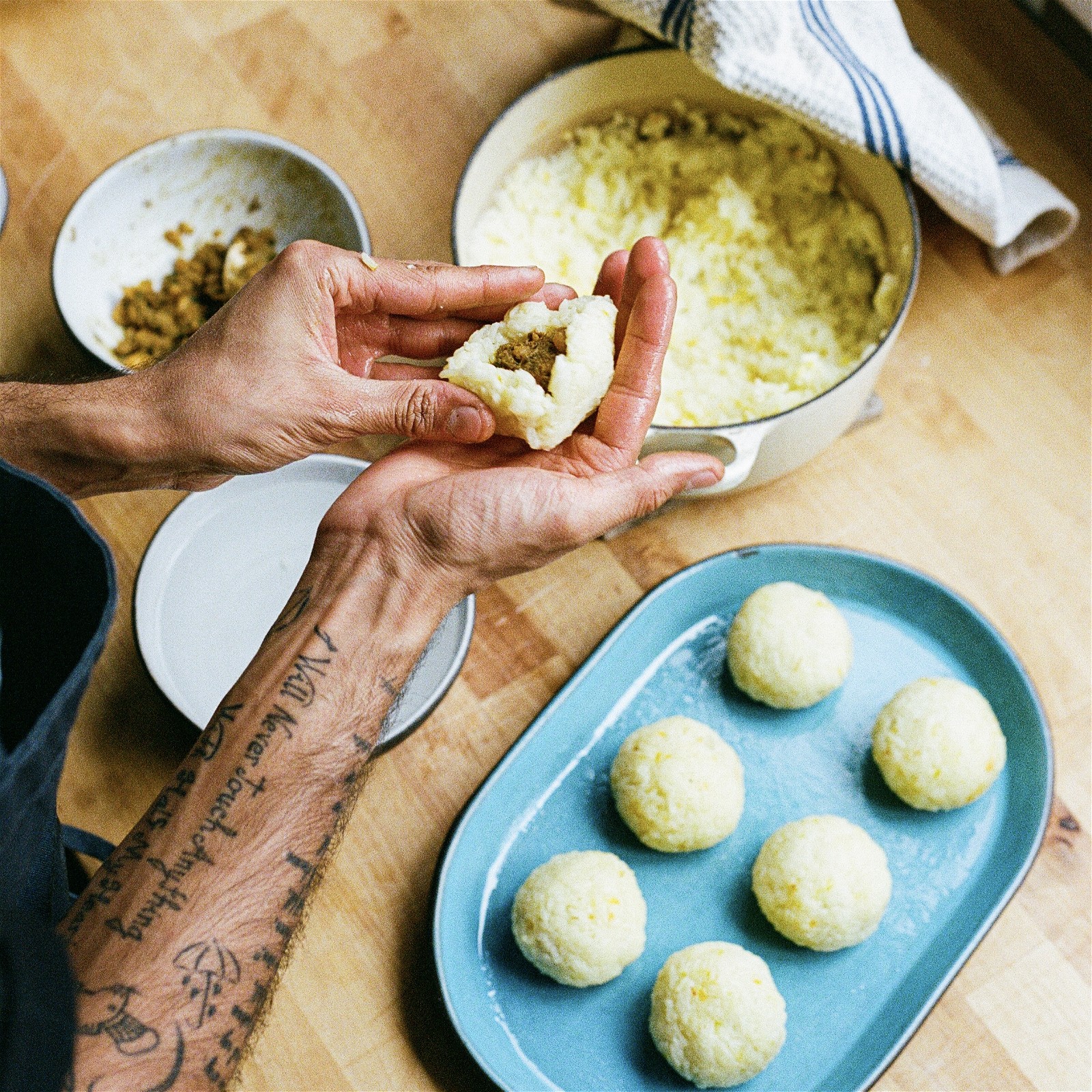Persian Kobeh (Savory Saffron & Meat Rice Dumpling)
Persian Kobeh (Savory Saffron & Meat Rice Dumpling)

Servings
10-12 dumplings
Prep Time
30-45 minutes
Cook Time
1.30
"An Iranian variation on the popular bulgur based Saudi dumpling kibbeh, saffron scented jasmine rice replaces the tradition steamed wheat in the exterior of this dumpling, and the mince meat in place of pine nuts features tender cooked tour dal. The filling is spiced with the fragrant flavors of advieh, the utilitarian Persian blend which gives way to generous notes of black pepper, cumin, coriander, clove, and nutmeg among many other spices. Virtually any meat filling can be used here though beef and lamb are most traditional. These dumplings were a staple of our childhood, exemplifying the regional influences that my mother grew up with in her small town of Khorramshahr, Khuzestan in the South of Iran, where many of the bordering countries from Iraq, Kuwait & Saudi Arabia enriched the expanse dinner tables and recipes of this province, creating very regionally specific hybrid recipes influenced by two or more cultures. These crispy rice dumplings are best made the day of and shallow fried and enjoyed right away."
Behzad Jamshidi
Ingredients
1 lb ground meat, ideally a mixture of beef and lamb
½ cup toor dal
1 medium onion, finely diced
1 small bunch of parsley, upper leaves and stems picked and finely chopped
2 cups chicken stock (alternatively use water)
-
1 tsp turmeric powder
-
1 tsp ground cinnamon
-
1 ½ Tbsp Advieh (use curry powder or baharat alternatively)
3 Tbsp olive oil, ghee or other flavorful fat
-
Salt & cracked pepper to taste
4 cups jasmine rice, rinsed in cool water once and drained through a colander or strainer
-
1g or a few threads of saffron
1 rock sugar cube or a pinch of ground sugar alternatively
-
3 Tbsp salt, sea salt ideally
6 cups of cold water
1 L frying oil (canola, vegetable, peanut, rice bran)
1 egg, yolk only
Fresh mint sprigs or other fine herbs
A dollop of labneh or thick yogurt
Gather:
For the Filling:
For the Rice:
To Cook:
To Garnish:
Directions
Prepare:
For the Filling:
Place your ½ cup of toor dal in a pot with 2 cups of chicken stock or water. Season with a few pinches of salt until the mixture tastes like a well-seasoned broth you would drink. Bring to a simmer over medium-low heat and cook for 30 minutes or so until the tour dal is soft and tender. If the outside begins to over cook before the center becomes tender, simply cut the heat and cover with a lid for another 20 minutes to allow the tour dal to hydrate and cook through evenly.
Meanwhile in a heavy based sauté pan, heat onions over medium heat with 3 tablespoons of olive oil or other fat of choice along with a pinch of salt which will help soft the onions and stop them from over caramelizing. Sauté until the onions are translucent and begin to caramelize at the edges. Add your ground meat and cook, using the back of a wooden spoon to break up the meat. Cook until evenly brown and golden all over, about 12-15 minutes.
Season your caramelized mixture of meat and onions with 1 teaspoon of turmeric, 1 teaspoon of ground cinnamon, 1 ½ tablespoons advieh (or other spice of choice) and season lightly with salt and cracked pepper. Sauté the spices for 30 seconds until deeply aromatic and toasted.
Add your toor dal along with any of the additional liquid in the pot and stir it thoroughly into the meat mixture. Cook over medium-low heat until all the additional moisture has evaporated, and the filling mixture begins to resemble a sloppy joe filling. Lastly add your parsley and adjust any seasonings to your preference and transfer your filling into a wide container, leaving it uncovered and placing it into the fridge to cool entirely.
For the Rice
Place the lightly washed rice into a heavy based pot or rice cooker covered with 6 cups of cold water and seasoned with 3 tablespoons of sea salt. The seasoned water should resemble the saltiness of a lightly seasoned pasta water. Bring the rice to a boil.
Meanwhile, grind 1 g of saffron in a mortar and pestle with 1 rock sugar cube or ground sugar until deeply orange and finely ground. Once the rice water is at a boil, dip the mortar and pestle sideways into the rice pot with a firm grip, and clean the inside of the motor out containing the saffron using the head of the pestle until the contents are rinsed out with rice water and the rice pot liquid is golden and yellow.
Cover the rice pot with a tight fitting lid and cook over low heat for 30 minutes or per rice maker instructions. Once cooked, cut the heat, and leave rice in the pot for 30 more minutes to help the rice soften and absorb more steam.
Using the back of a spoon, gently mix and fluff the rice and cover again with a lid, as handling the rice when warm is critical to making the dumplings. Lightly mix every 5 minutes or so, opening the lid to release some heat until the rice mixture is at a temperature bearable to handle with your fingers.
For the Dumplings:
Prepare a dumpling making station for yourself with a sheet tray or a plate lightly brushed with oil, which is where you will place the finished dumplings, a tablespoon to scoop the filling, a small soup sized bowl of cold water for dipping your hands into.
Dip your fingers into the bowl of water, and massage your palms, creating a thin lawyer of water across your hands. Too much water and handling the rice will cause the granules to unstick from one another, and too little water and the starch from the rice will cause it stick to your hands.
Take 100 grams of rice into the palm of your hands (about the size of a large lemon) and lightly mash and squeeze the rice between your two hands for 10 seconds of so until it begins to resemble a meat ball. Hold the mashed rice dumpling in one hand, and with the fingers of the same hand, dip the tips of your fingers into water and brush the palm of your opposite hand with the water.
Press the rice dumpling over your opposite palm, which you covered with water and while cupping your hand slightly, spread and press the rice into a flat round as wide as an orange, and about the even thickness of your pinky. Place 1 heaping tablespoon or 40g of the cooled filling into the center of the dumpling. Using your free hand, pull the outer edges of the rice over the dumpling as to close the rice over the filling, add small amounts of rice to fill any gaps as needed.
Dipping the fingers of the available hand into water once again, cover the palm of your free hand with water using your fingertips and transfer the rice dumpling to this opposing hand, repeat the moistening process of the palm with the other hand that you just transferred the dumpling from, and gently press the dumpling between both hands, molding the dumpling into a sphere-like hockey puck shape.
Place your finished dumpling on your oil brushed tray or container and repeat the process until you run out of either rice or filling.
Cook:
Choose a heavy based pot, Dutch oven or high sided pan such as a cast iron skillet or sauté pan. Fill the pan with 1L of frying oil (just enough to come up the sides of the dumplings, but not cover them) and bring it up to frying temperature of around 350°F over medium heat. To check that the temperature is correct without a thermometer, place just a corner of the dumpling into the top of the hot oil, the oil should produce a generous and theatrical bubbling if it is hot enough and ready, if your oil begins to produce a thick smoke, you have over heated the pot and you should refrain from frying dumplings at this heat as they will explode in the oil and produce a terrible flavor. Either wait until the oil stops producing smoke and has cooled down, or ideally, as to not pass along the flavor of burnt oil to your dumplings, reheat new oil in a new pan.
Meanwhile whisk an egg yolk in a small bowl and lightly brush all sides of the dumplings with egg yolks to both help seat the dumplings and to help produce a beautiful golden color when cooked.
Once the oil is at the right temperature, place the dumplings into the pan, working with 3-4 at time as to not overcrowd the pan, which can cause the crust to go soggy, fry the dumplings on either side for 4-5 minutes. You’re looking to crispy up the outside of the dumpling rice by shallow frying and allowing the dumpling to lose some moisture, do not cover the dumpling with oil.
Once crisp and golden all over, carefully remove the dumpling out of the oil and place on a paper towel to blot dry. Allow the dumpling to cool for several minutes and enjoy with fresh herbs and yogurt.








